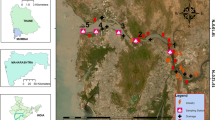Abstract
The Almendares River is central to recreational and other activities in Havana, Cuba. However, monitoring indicated significant heavy metal contamination in river sediments, especially below Calle 100, the largest landfill in Havana. This work extended previous sediment studies by determining complementary Cu, Pb, Ni, Cr, Cd, and Zn levels in indigenous water hyacinths (Eichhornia crassipes; EC) above and below the landfill. Pb, Cu, and Zn were significantly elevated in EC roots below the landfill and also correlated with sediment data (p < 0.05), implying elevated levels likely result from landfill activity and might be useful biomonitors as river remediation proceeds.





Similar content being viewed by others
References
Boswell MT, Gore SD, Lovison G, Patil GP (1996) Annotated bibliography of sampling Part A: 1936–92 composite. Environ Ecol Stat 3:1–50
Chigbo F (1982) Uptake of arsenic, cadmium and mercury from polluted water by the water hyacinth E. crassipes. Environ Poll 27:31–36
Gonçalves MA, Nogueira JMF, Figueiras J, Putnis CV, Almeida C (2004) Base-metals and organic content in stream sediments in the vicinity of a landfill. Appl Geochem 19:137–151
Gonzalez H (1991) Mercury pollution caused by a chlor-alkali plant. Water Air Soil Pollut 56:83–93
Gonzalez H, Lodenius M, Otero M (1989) Water Hyacinth as indicator of heavy metal pollution in the tropics. Bull Environ Contam Toxicol 43:910–914
González Y, García O, Infante A, Rodríguez N, Martín A, Beltrán J, Chanquet M (2005) Current situation of the production of landfill leachates in the City of Havana. Environmental impact and proposed treatment systems, vol 6. Contribución a la Educación y la Protección Ambiental, pp I-32–I-46. ISBN 959-7136-35-X
Klumpp A, Bauer K, Framz-Gerstein C, de Menezes M (2002) Variation of nutrient and metal concentrations in aquatic macrophytes along the Rio Cachoeira in Bahia (Brazil). Environ Int 28:165–171
Lasat MM, Pence NS, Garvin DF, Ebbs SD, Kochian IV (2000) Molecular physiology of zinc transport in the Zn hyperaccumulator Thlaspi caerulescens. J Exp Bot 342:71–79
Lu X, Kruatrachue M, Pokethitiyook P, Hompok K (2004) Removal of cadmium and zinc by water hyacinth, Eichhornia crassipes. Sci Asia 30:93–103
Maddock J, Santos M, Marinho R (1988) Eichhornia crassipes as a biological monitor of heavy metals in surface waters. In: Metal in coastal environment of Latin American. Springer, Berlin, p 297
Miller NJ, Miller JC (2002) Statistics and chemometrics for analytical chemistry. Prentice Hall, New York
Mora I (2004) Water analysis of Almendares River. MSc thesis, Havana University, Cuba
Niño-Sulkowska M, Lot A (1983) Demographic analysis of the floating macrophyte Eichhornia crassipes (Mart.) solms: growth dynamics at selected sites in Mexico. Bol Soc Bot Méx 45:71–83
JICA: Japan International Cooperation Agency (2005) Study on integrated management plan of municipal solid waste in Havana City, vol. II. Draft Final Report. Prepared by Nippon Koei Co. Ltd., Pacific Consultants International
Olivares S, de la Rosa D, Lima L, Graham DW, Alessandro K, Borroto J, Martinez F, Sanchez J (2005) Assessment of heavy metal levels in Almendares River sediments—Havana City, Cuba. Water Res 39:3945–3953
St-Cyr L, Cattaneo A, Chasse R, Fraikin CGJ (1997) Technical evaluation of monitoring methods using macrophytes, phytoplankton and periphyton to assess the impact of mine effluents on the aquatic environment. Report prepared for the AETE Program, CANMET. Natural Resources Canada, Ottawa
Tessier A, Turner DR (1995) Metal speciation and bioavailability in aquatic systems. Wiley, London
Vesk PA, Allaway WG (1997) Spatial variation of copper and lead concentrations of water hyacinth plants in a wetland receiving urban run-off. Aquat Bot 59:33–44
Vesk PA, Nockolds CE, Allaway WG (1999) Metal localization in water hyacinth roots from an urban wetland. Plant Cell Environ 22:149–158
Author information
Authors and Affiliations
Corresponding author
Rights and permissions
About this article
Cite this article
Olivares-Rieumont, S., Lima, L., De la Rosa, D. et al. Water Hyacinths (Eichhornia crassipes) as Indicators of Heavy Metal Impact of a Large Landfill on the Almendares River near Havana, Cuba. Bull Environ Contam Toxicol 79, 583–587 (2007). https://doi.org/10.1007/s00128-007-9305-5
Received:
Accepted:
Published:
Issue Date:
DOI: https://doi.org/10.1007/s00128-007-9305-5




